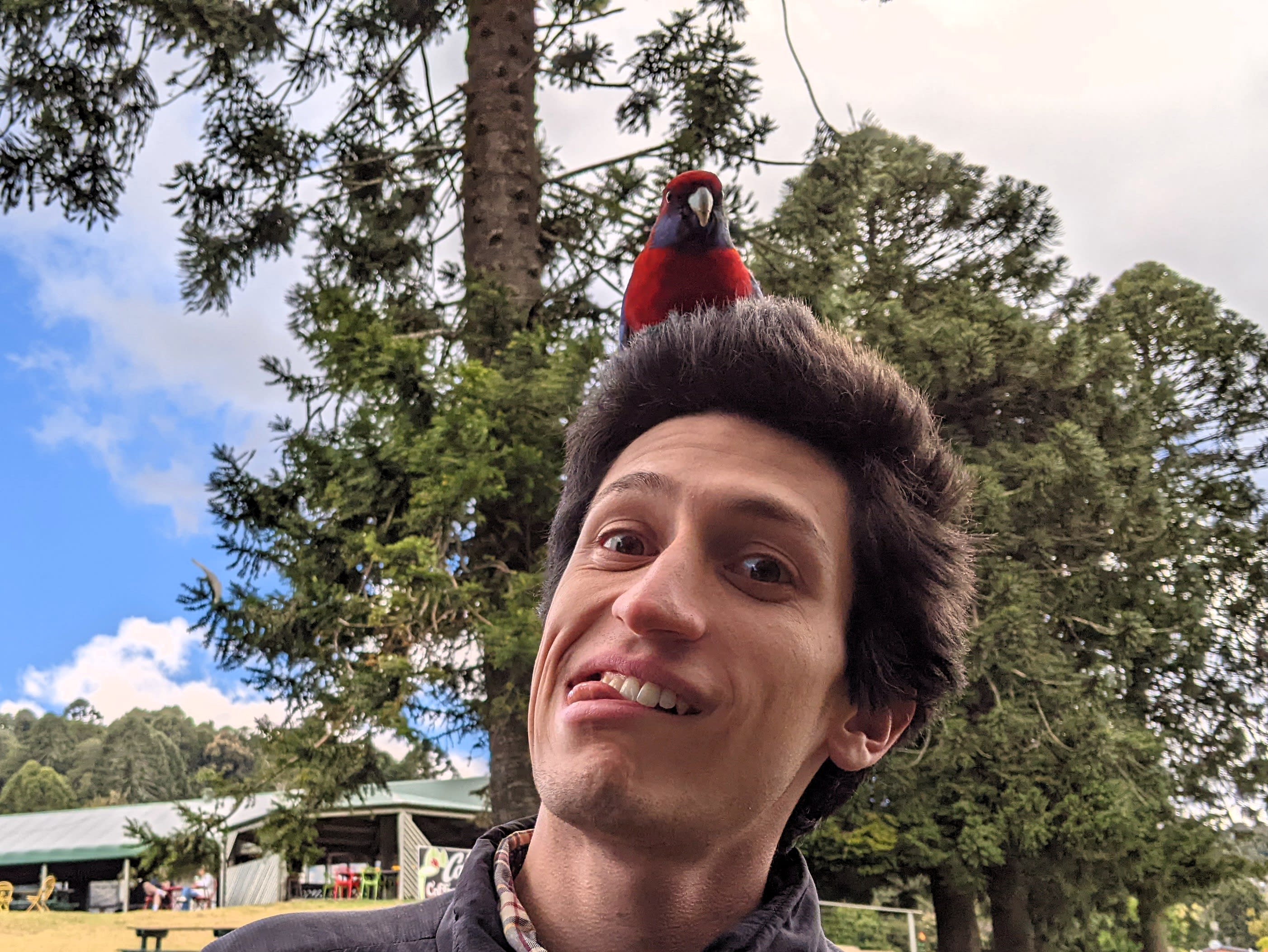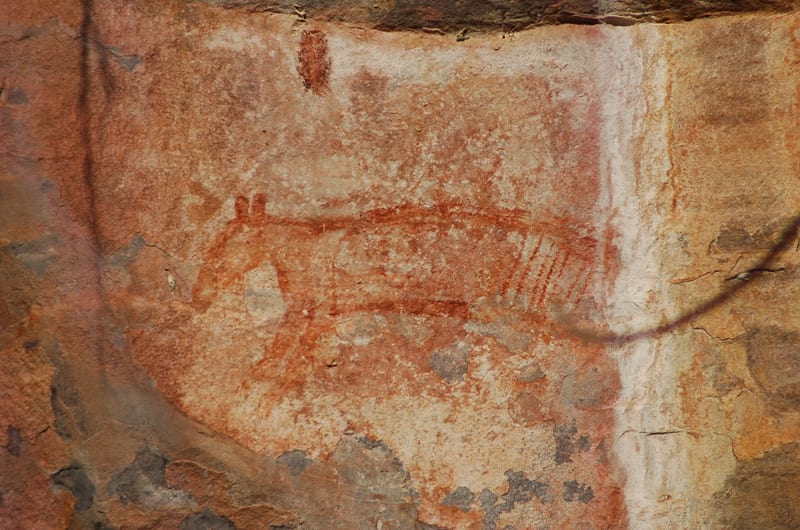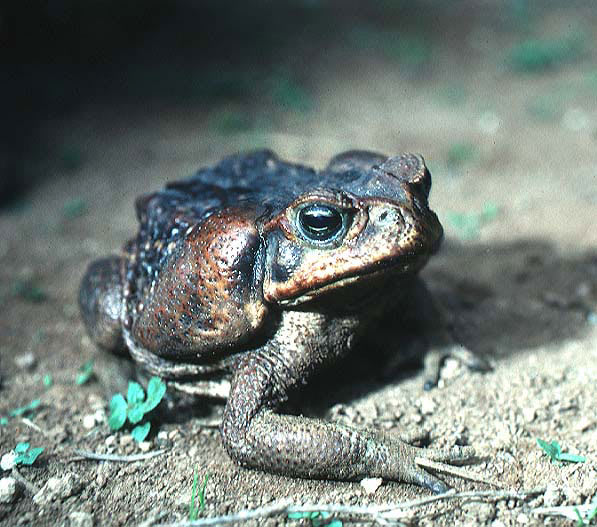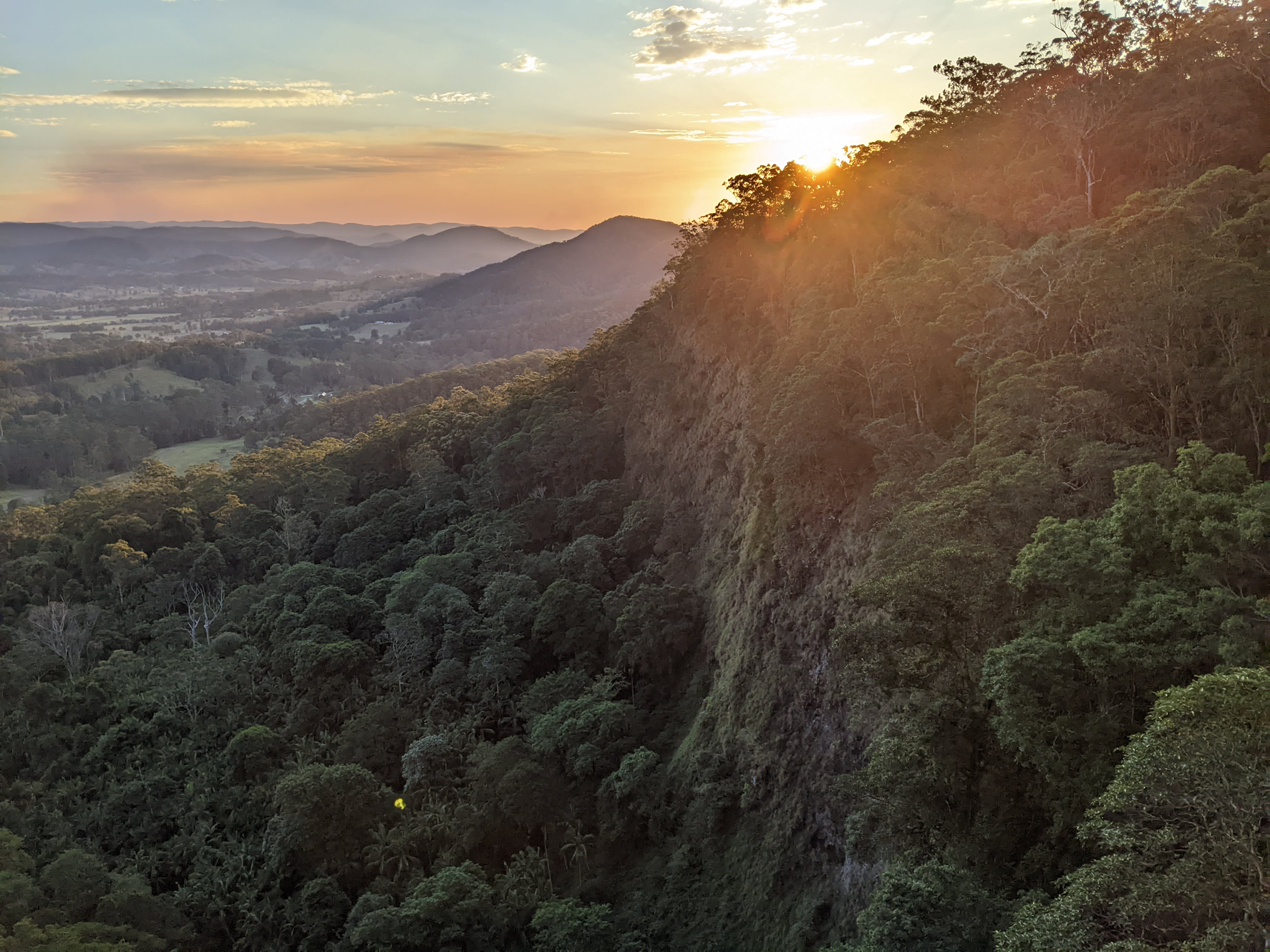G’day! I recently got back from a really lovely extended break down under. There was a lot (‘heaps’) to see and do! - including visiting family and friends with my partner in crime, sampling some unspecified quantity of homebrewed rum, and taking afternoon tea with the locals (humans and wildlife).
A friendly local (crimson rosella) I met in the Bunya mountains
I learned a lot from hosts, guides, museums, and simply from keeping eyes and ears open while indulging my passion for wildlife and nature while walking in the bush. But the main topic I’ll touch on here is the pervasive sense of barely-controlled or out-of-control ecosystem impacts, which is felt pretty viscerally there.
Oly, don’t you mainly think and write about AI and computer science? This one is mostly (superficially) about nature, but don’t worry, we’ll get there.
In Un-unpluggability I actually had some Australian cases in mind when I wrote:
Replication and growth (with reinvestment) get special mentions as they naturally produce exponential expansion (until constraints are reached), which in practice often manifests as first imperceptible and then rapid escalation.
Replicating systems also give rise to a kind of robustness due both to redundancy and repair. They are notoriously difficult to shut down, which is why autonomous replication is rarely a deliberate part of human designs—though we see it employed under well-understood and controlled conditions in agriculture and some industry, maliciously in computer viruses and bioweapons, and sometimes accidentally in biosphere interventions. In fact, in biological, zoological, and related sciences, great care is usually taken to avoid inadvertently unleashing autonomously replicating systems, though this remains sometimes insufficient[1].
Examples:
pandemics
invasive species (e.g. plant weeds)
computer viruses
wildfire
rumours and ideologies?
But why is great care usually taken to avoid unleashing autonomously replicating systems? Well, it’s been a hard-won lesson, known intimately within some disciplines and circles, while less perceptible or understood in others. And we’re still making a lot of mistakes!
Australia, the big experiment
Australia, separated from the rest of the world’s continents for tens of millions of years, was in many ways a natural experiment here: humans and our water-(and later air-)transport were one of the only ways in or out for the vast majority of species. Before we really knew what we were doing, sometimes accidentally and other times misguidedly deliberately, like good little experimentalists, we humans were responsible for an unprecedentedly rapid introduction of new foreign organisms, and we got the chance to watch the effects unfold in front of us. The experiment, this introduction of foreign species was… successful, if by ‘successful’ you mean ‘devastating and difficult or impossible to roll back’.
Lessons learned?
Replication and growth! Expansionism! Within the jurisdiction of Australia, and in the limited domain of biosphere interventions, the relevant decisionmakers appear to have taken this lesson on board. Australia has the tightest border controls for bio of any nation. In my experience it wasn’t all that, given the stakes, but they did scrub my boots on the way in, in case I’d brought any nasty English countryside with me.
It’s unclear to me to what extent the First Nations Aboriginal people, the original (human) custodians of Australia, had learned this lesson, which would therefore merely be being remembered or rediscovered today. The popular stereotype I encountered was of a wise and learned people living in harmony with nature prior to European incursion. Certainly in recent centuries on the whole they were… more restrained than their European and Asian cousins in the destruction of the environment. Various Aboriginal cultural practices among different groups seem to have been designed or fit for the purpose of environmental protection[2], but a fair share of casualties undeniably occurred under their ancestors’ watch too, notably many species which are now counted only in the fossil record and on the oldest of Aboriginal artworks. There’s a reason the Thylacine, whose fossils are found throughout Australia, was known colloquially as the ‘Tasmanian Tiger’: by the time Europeans arrived, the only remaining population lived even more remotely on the island of Tasmania! A similar story is playing out with the ‘Tasmanian Devil’, also once widespread on the mainland. Were the same lessons learned, once, only to be forgotten when the balance of power shifted to the European colonists? I don’t think the archaeological or cultural record is intact enough that we’ll ever answer that question.
A probable Thylacine depicted in ancient art at Ubirr. nettispaghetti, Wikimedia commons
Characters and critters
Besides a burgeoning defensive stance against future incursions, what mitigations are pursued?
The main means of halting expansionist systems is to remove or protect the resources used for expansion, or intervene in some other way to reduce the rate. Very commonly we are forced to simply await resource exhaustion (as with some wildfires) or learn to live with it[3] (as with endemic diseases or established invasive species).
My discussion of mitigation in un-unpluggability
In no particular order, here’s a shortlist of some uncontrolled introduced species I encountered on my limited excursions in Australia.
cane toads (perhaps the most famous on the list, and spotlighted below)
various devastating tree infections
humans[4]
dingo[5]
cats and foxes
rats and mice
deer
rabbits
pigs
Not one of these has yet been brought back under control despite numerous efforts. We’re well into the realm of ‘learn to live with it’ (though try telling that to the extinct or threatened native wildlife, Aboriginal communities whose traditional food sources have dwindled, or farmers whose crops are at risk).
Cane Toad case study: Fighting fire with fire
In the early 20th Century, sugarcane farmers became plagued by cane beetles, which eat the leaves and whose larvae destroy the canes’ roots. Some enterprising genius suggested that, hey, don’t toads eat beetles? So they checked, and indeed, there was such a thing as toads, and a South American species that would happily eat these particular beetles if it got the chance. (Behavioural evaluation, success!) Rather than poisoning or otherwise directly attacking the beetles, why not delegate to a small population of beetle-controlling amphibians, the toads? Apparently a few people raised concerns, but they were quickly overruled and a hundred or so toads were brought in, bred, and released, becoming known as ‘cane toads’.
Bufo marinus, Eli Greenbaum, Wikimedia commons
In the mid 20th Century, sugarcane farmers were still plagued by cane beetles, which eat the leaves and whose larvae destroy the canes’ roots. It turns out that cane toads don’t jump or climb well, so outside of the lab, where beetles live at the top of sugar cane, the toads were all but useless at their intended purpose. (Out of context failure!)
But the toads were a success, in their own terms: unexpectedly unfussy eaters, prolific reproducers, and poisonous to most wildlife, they have rapidly colonised Queensland state, lately expanding into New South Wales and the Northern Territories, while being resilient to every attempt at pushing them back. We fought fire (cane beetles) with fire (toads), and ended up with two fires! Meanwhile, pre-existing species, especially predators unfamiliar with the toads’ toxins, have been pushed toward extinction[6].
This is fine
In the 21st century, a few new kinds of self-replicating ‘fire’ are being considered for toad control. First, toad viruses! This sounds like the start of the plot of something that ends badly, at least for other wildlife and native amphibians (which are already having a hard time) - a third fire to add to the mix?
The other, more high tech approaches involve deliberate introduction of driving genes, genes which subvert the usual ‘fair’ sexual recombination process resulting in much greater than 50% chance of appearing in a given offspring. If the driving gene is also one which reduces fitness in the traditional sense (for example, by being always male), the population can be reduced or even eliminated by the rapid colonisation of its gene pool by the driving gene. Various other genetic shenanigans along similar lines have been suggested. My take is that, despite sounding even more sci-fi, this driving gene approach is far less liable to go awry because it recruits, as a very robust boundary, the natural incompatibility of genetic mixing between species, in contrast to pathogens, which like to mutate and hop between hosts. On the other hand, further developing this technology may be a risky prospect indeed since it’s so ripe for abuse in other contexts! We’ll see how successful these approaches turn out to be as and when they are rolled out.
Incidentally, Burt and Trivers’ book Genes in Conflict is a fascinating and rich dive into the often surprisingly-computational world of driving genes and other intragenomic conflict.
All of this goes to exemplify that, when unleashing autonomously replicating systems, rollback is seriously difficult. Fighting replicators with replicators usually hasn’t worked so far[7], but there’s a first time for everything.
Casualties: endless formerlies most beautiful
Darwin visited Australia (I didn’t know this until I came there). In his day, whether he was aware of it or not, we’d already lost[8]
giant kangaroos
giant ‘wombats’
giant echidnas
giant platypus
Genyornis (a giant flightless bird)
Megalania (a giant predatory lizard)
Thylacoleo (a giant predatory marsupial)
Quinkana (a giant semi-terrestrial crocodile)
(there’s a theme here; larger creatures are often fewer in number and at more precarious positions in a disrupted food chain)
mainland Thylacine (‘Tasmanian tiger’)
mainland Sarcophilus (‘Tasmanian devil’)
Since Darwin’s time, post-Aboriginal colonisers have worked very hard at bringing new and exciting devastation to the environment. We’ve since lost
Thylacine (Tasmanian populations lost, captive individuals died without offspring)
various bandicoots[9] and bilbies
various possums
various wallabies and kangaroo species
several large fruit bats
emu relatives and various fowl
numerous pigeons and parrots
These are just the ones which are front of mind for me from previous reading and after visiting a few museums. There’s a longer list on Wikipedia and this is not to mention plants and marine life!
I’m not an ecology preacher. It’s sad, devastating perhaps, that these rather wonderful creatures can no longer be found. But for all I know they lived terrible, brutish lives of struggle, disease and misery, and they’re better off absent (I’m half joking). The main point is that, mostly, these species weren’t literally slaughtered to extinction by humans—instead, humans’ activities, and more often than not one or another autonomous replicator[4:1] that we set in motion, sealed their fate. And not one of these effects was deliberate[10].
Takeaways
Replication is extremely potent! Nature actually hits us in the face with evidence for this every day, but because it all seems so normal, we don’t always take the lesson on board. Because most replicators happen to exist in states of approximate equilibrium with each other, we really only witness the power of the exponential when there’s some shock to the system: a new habitat unlocked, an invasive species introduced, or a novel pathogen burning through the available resources until some new equilibrium is reached.
Large groups of well-resourced people attempting to face such replicators head-on have found it to be challenging or impossible to put the cat back in the bag. I for one have learned to take risks which route via something replicating very seriously indeed—hence the special place it gets in my list of un-unpluggabilities. Covid was just another in a list of wakeup calls on this front.
Australians have learned this lesson in the limited domain of biology, perhaps more than once! And they’re taking action on it, sometimes in pretty creative and ambitious ways.
Fighting fire with fire is an amusing and audacious approach that just might work for some bio interventions, but it’s domain-specific, contingent, and untested: there’s no law of nature that the medicine is a mirror of the poison, so we can’t expect this to work for nonbiological systems without very good reason.
I write and think about AI a lot. Let’s not get into a situation where AI can even semi-autonomously replicate, without thinking very hard about the consequences, including potential outcompetition of other intelligences. It only has to happen once, somewhere, by accident, and it might be hard or impossible to walk back from.
- ↩︎
Including some credible suggestions (e.g. by US government agencies) that the ongoing coronavirus pandemic may have had an accidental lab leak as its origin, as well as more thoroughly verified cases of accidental pest introduction or pathogens finding their way out of laboratory contexts
- ↩︎
Notably, strong taboos against hunting of certain keystone species like Cassowary, hereditary land custodianship including some measure of preservation duty, and management of controlled burning in many locations (which pre-emptively exhausts the potential for more devastating wildfires, as well as opening the ground for various fire-adapted native plant species). It seems likely that other such historic practices are entirely or substantially forgotten, and I’ll only have encountered some subset of those remembered.
- ↩︎
Assuming it hasn’t already taken our life or livelihood, that is
- ↩︎↩︎
Don’t forget that humans are another autonomously-replicating introduced species in Australia (not to mention nearly everywhere else), it’s just that we introduced ourselves (more than once).
- ↩︎
Yes, the dingo is far from native. How do you think a dog got to Australia?
- ↩︎
Especially monitor lizards or ‘goannas’, habitual hunters of amphibians and formerly among Australia’s most characteristic and visible predator groups, as well as snakes. Some of the smarter birds have reportedly learned in some locations to carefully eat around the poison glands.
- ↩︎
A counterexample: the prickly-pear or paw-paw is another species inadvertently unleashed on the Australian ecosystem, which has caused some displacement of native wildlife. A moth (believe it or not, Cactoblastis!) was found which actually does seem to work as a self-regulating suppressant of the cacti. Unlike cane toad, these moths haven’t adapted to eat much of the native flora, and their presence appears to be less disruptive to other parts of the food chain.
- ↩︎
To be clear, human fault is far from definitive in all of these cases. Some effect from naturally changing climate is also suspect. But all of these genera were co-temporal with humans in Australia.
- ↩︎
I’m told Crash is still alive and well
- ↩︎
Actually who knows, the Aboriginal ancestors faced a pretty horrifying range of megafauna; maybe they were deliberate. Giant, terrestrial crocodiles? 4-7m predatory lizards? There’s environmental preservation and then there’s self-preservation.




You may enjoy reading The Future Eaters (Flannery 2004), as an ecological history of Australia and the region—covering the period before first human settlement, the arrival of Indigenous peoples, and later European colonization.